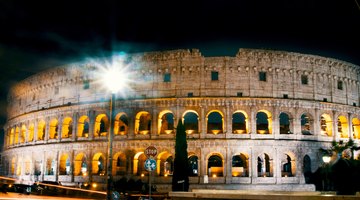Rome was not built in a day, nor did the mighty Roman Empire collapse overnight. Relentless attacks by fearsome, marauding barbarians slowly drained the economy and ended the Roman reign of prosperity. To this day, the Roman Empire is considered a notable part of human history. While Rome prospered for more than 700 years, its demise in 476 A.D. stemmed from internal and external causes. With Rome gone, the transition was far from easy, forcing the world to reinvent itself during a long period.
The Beginning of the End
First, the Roman Empire became divided between the East, under Constantinople, and the West, ruled by several different leaders. This double-reign was a new concept that weakened the empire. Infighting over leadership and decaying government strength helped set the stage for other groups, such as the Greeks and Byzantines, to become uncooperative. With its foundations weakened, outside powers were also able to cripple the Romans.
Rise of Its Enemies
External military threats were a major cause of Rome's fall, and its effects spread across the empire. During its days of prosperity and conquest, many of Rome's enemies were scattered tribes who lived in a small number of villages. After Rome was divided, a powerful group known as the Huns began moving west, their numbers growing with captured prisoners and new allies. People from all walks of life were eager to reap the rewards of war. They kept the pressure on the Roman Empire, while nations such as Russia became powerful and sophisticated. What had been barbarian villages in Germany soon turned into 2,300 walled towns and cities. Out of these rose the countries of Denmark, Sweden and Poland. Meanwhile, groups such as the Arabs and Saracens of India and Spain sat in anger and contempt. Once its enemies united, the Roman Empire was surrounded with new competition without the proper leadership to address it.
Economic Problems
The Roman economy was affected by weak currency and high inflation. With all the money going toward national defense, taxes were raised to compensate. Few people actually got a chance to enjoy Rome's prosperity. The value of Roman money plummeted to the point that bartering was preferable to paying for goods. Also, many Romans lost their jobs because of cheaper slave labor. As a result, the government subsidized the working class. Many workers chose to simply live off of these subsidies, costing the government even more money.
Over-Expansion
A big reason for the Roman Empire's collapse was the geographical extent of its military conquest. Rome's constant expansion required more resources and manpower to defend its borders. Additionally, conquered civilizations hated the Romans, so rebellions were a constant problem. All of these issues required mammoth military spending and recruitment. Manpower became so scarce that even conquered societies were allowed to join the ranks. In turn, this gave barbarians intimate knowledge of Roman battle tactics.
Lasting Effects
Regardless of the reasons, Rome had a profound impact on the world. When Rome's infrastructure fell, so did the quality of life. What followed were the Dark Ages, which can be grouped into two separate eras. The first lasted until 700 A.D. because of the destruction of trade and infrastructure. After a brief revival, a second decline took place around 1000 A.D. as a result of invasions by Vikings from Scandinavia and Magyars from Hungary. Essentially, whatever stability that Rome provided was gone, and many new nations had to build themselves on their own.
Related Articles
References
Writer Bio
Alex Saez is a writer who draws much of his information from his professional and academic experience. Saez holds a Bachelor of Arts in English literature from Queen's University and an advanced diploma in business administration, with a focus on human resources, from St. Lawrence College in Kingston, Ontario.











